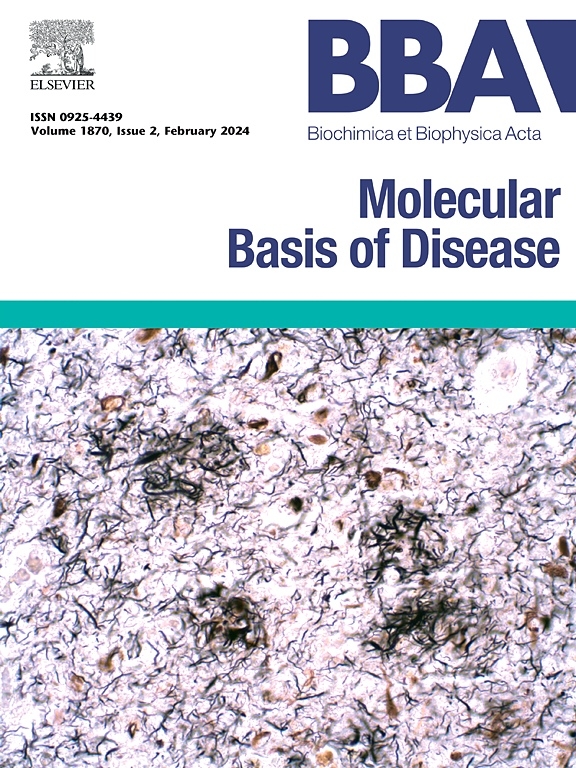Combined inhibition of EGFR and FGFRs with Cetuximab and Infigratinib showed effectiveness and relevance in proliferation and migration of HNSCC cell lines
IF 4.2
2区 生物学
Q2 BIOCHEMISTRY & MOLECULAR BIOLOGY
Biochimica et biophysica acta. Molecular basis of disease
Pub Date : 2025-05-29
DOI:10.1016/j.bbadis.2025.167940
引用次数: 0
Abstract
Head and neck squamous cell carcinoma (HNSCC) represents a significant oncological challenge, necessitating novel treatments due to high global mortality. The current study focuses on the potential of combining Cetuximab (CTX), targeting EGFR, and Infigratinib (BGJ), targeting FGFRs, to improve treatment outcomes.
The effects of CTX and BGJ on HNSCC cell lines were investigated by analyzing cell count and gap closure to assess proliferation and migration. Immunohistochemistry was used to assess EGFR and FGFRs expressions, and responses to related growth factors were studied.
CTX primarily reduced gap closure in the migration assay, while BGJ reduced cell counts more clearly. Combined application enhanced performance in three out of four cell lines. All cell lines exhibited high EGFR expression, while KGFR expression was observed in a subpopulation. EGF stimulation led to cell elongation and an increase in size in three cell lines, accompanied by notable changes in migration. KGF affected cell morphology and migration in one cell line. This study shows that the combination of CTX and BGJ was most effective in the cell lines, highlighting the crucial roles of EGFR and KGFR, with KGFR potentially mediating the effects of BGJ. The findings suggest that adding targeted therapies for receptors on relevant cell subpopulations may enhance outcomes in therapy.
西妥昔单抗和消炎替尼联合抑制EGFR和fgfr显示出对HNSCC细胞系增殖和迁移的有效性和相关性。
头颈部鳞状细胞癌(HNSCC)提出了重大的肿瘤学挑战,由于全球死亡率高,需要新的治疗方法。目前的研究重点是靶向EGFR的西妥昔单抗(CTX)和靶向fgfr的炎症替尼(BGJ)联合治疗的潜力,以改善治疗结果。研究了CTX和BGJ对HNSCC细胞增殖和迁移的影响。免疫组织化学检测EGFR和fgfr的表达,并研究对相关生长因子的反应。在迁移实验中,CTX主要减少间隙关闭,而BGJ更明显地减少细胞计数。联合应用程序提高了四分之三的细胞系的性能。所有细胞系都表现出高EGFR表达,而KGFR表达在一个亚群中被观察到。EGF刺激导致三种细胞系的细胞伸长和大小增加,并伴有明显的迁移变化。在一个细胞系中,KGF影响细胞形态和迁移。本研究表明CTX和BGJ联合使用对细胞系最有效,强调了EGFR和KGFR的关键作用,KGFR可能介导BGJ的作用。研究结果表明,增加相关细胞亚群受体的靶向治疗可能会提高治疗效果。
本文章由计算机程序翻译,如有差异,请以英文原文为准。
求助全文
约1分钟内获得全文
求助全文
来源期刊
CiteScore
12.30
自引率
0.00%
发文量
218
审稿时长
32 days
期刊介绍:
BBA Molecular Basis of Disease addresses the biochemistry and molecular genetics of disease processes and models of human disease. This journal covers aspects of aging, cancer, metabolic-, neurological-, and immunological-based disease. Manuscripts focused on using animal models to elucidate biochemical and mechanistic insight in each of these conditions, are particularly encouraged. Manuscripts should emphasize the underlying mechanisms of disease pathways and provide novel contributions to the understanding and/or treatment of these disorders. Highly descriptive and method development submissions may be declined without full review. The submission of uninvited reviews to BBA - Molecular Basis of Disease is strongly discouraged, and any such uninvited review should be accompanied by a coverletter outlining the compelling reasons why the review should be considered.

 求助内容:
求助内容: 应助结果提醒方式:
应助结果提醒方式:


